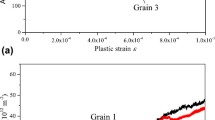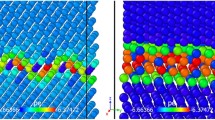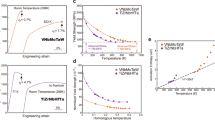Abstract
Temperature- and irradiation-assisted failure mechanisms in miscible phase boundaries are clarified via atomistic calculations. We first establish the temperature-dependent brittle-to-ductile transition in U–Zr miscible phase boundaries. Our results confirm that these boundaries are mostly brittle at low temperatures and ductile at elevated temperatures. We then investigate the changes induced by irradiation on the fracture mechanisms in such phase boundaries. The irradiation-induced defect accumulation follows a multi-stage process that starts with the accumulation of isolated small dislocation loops before transitioning to the saturation and growth of larger dislocation loops and end up with a reorganization into forest dislocations. The accumulation of loops is the primary feature to participate in the delineation between brittle and ductile interfacial fracture in irradiated phase boundaries. At low damage levels, radiation defect interactions with the crack tip are limited and U–Zr miscible boundaries fail through the emission of dislocations ahead of the crack tip followed by brittle cleavage in agreement with the classical Griffith’s criterion for crack stability. At higher damage levels, the failure mode transitions from brittle crack growth to ductile void growth. In this case, the microcrack tip is blunted by the high density of pre-existing, radiation-induced defects in the vicinity of the crack. This interaction leads to the development and growth of a cavity at the interface as opposed to interfacial cleavage.









Similar content being viewed by others
References
Arjhangmehr A, Feghhi SAH (2016) Irradiation deformation near different atomic grain boundaries in \(\alpha \)-Zr: an investigation of thermodynamics and kinetics of point defects. Sci Rep 6:23333. https://doi.org/10.1038/srep23333
Barrows W, Dingreville R, Spearot DS (2016) Traction-separation relationships for hydrogen induced grain boundary embrittlement in nickel via molecular dynamics simulations. Mater Sci Eng A 650:354–364. https://doi.org/10.1016/j.msea.2015.10.042
Basak C, Prasad GJ, Kamath HS, Prabhu N (2009) An evaluation of the properties of as-cast U-rich U–Zr alloys. J Alloy Compd 480(2):857–862. https://doi.org/10.1016/j.jallcom.2009.02.077
Beyerlein I, Demkowicz M, Misra A, Uberuaga BP (2015) Defect–interface interactions. Prog Mater Sci 74:125–210. https://doi.org/10.1016/j.pmatsci.2015.02.001
Brinkman JA (1954) On the nature of radiation damage in metals. J Appl Phys 25(8):961–970. https://doi.org/10.1063/1.1721810
Bruemmer SM, Simonen EP, Scott PM, Andresen PL, Was GS, Nelson JL (1999) Radiation-induced material changes and susceptibility to intergranular failure of light-water-reactor core internals. J Nucl Mater 274(3):299–314. https://doi.org/10.1016/S0022-3115(99)00075-6
Chartier A, Marinica M-C (2019) Rearrangement of interstitial defects in alpha-Fe under extreme condition. Acta Mater 180:141–148. https://doi.org/10.1016/j.actamat.2019.09.007
Chartier A, Onofri C, Van Brutzel L, Sabathier C, Dorosh O, Jagielski J (2016) Early stages of irradiation induced dislocations in urania. Appl Phys Lett 109:181902. https://doi.org/10.1063/1.4967191
Chen EY, Dingreville R, Deo C (2018) Misfit dislocation networks in semi-coherent miscible phase boundaries: an example for U–Zr interfaces. Comput Mater Sci 154:194–203. https://doi.org/10.1016/j.commatsci.2018.07.065
Chen EY, Deo C, Dingreville R (2019) Irradiation resistance of nanostructured interfaces in Zr-Nb metallic multilayers. J Mater Res 34(13):2239–2251. https://doi.org/10.1557/jmr.2019.42
Chen E, Deo C, Dingreville R (2020) Reduced-order atomistic method for simulating radiation damage in metals. J Phys 32:045402. https://doi.org/10.1088/1361-648X/ab4b7c
Collins R (1986) Factors determining radiation-induced mixing at interfaces. Radiat Effects 98(1–4):1–20. https://doi.org/10.1080/00337578608206092
Dingreville R, Aksoy D, Spearot DE (2017) A primer on selecting grain boundary sets for comparison of interfacial fracture properties in molecular dynamics simulations. Sci Rep 7(1):8332. https://doi.org/10.1038/s41598-017-08637-z
Gumbsch P, Riedle J, Hartmaier A, Fischmeister HF (1998) Controlling factors for the brittle-to-ductile transition in tungsten single crystals. Science 282(5392):1293–1295. https://doi.org/10.1126/science.282.5392.1293
He M-R, Johnson DC, Was GS, Robertson IM (2017) The role of grain boundary microchemistry in irradiation-assisted stress corrosion cracking of a Fe-13Cr-15Ni alloy. Acta Mater 138:61–71. https://doi.org/10.1016/j.actamat.2017.07.042
Hull D, Rimmer DE (1959) The growth of grain-boundary voids under stress. Philos Mag 4(42):673–687. https://doi.org/10.1080/14786435908243264
Li N, Martin MS, Anderoglu O, Misra A, Shao L, Wang H, Zhang X (2009) He ion irradiation damage in Al/Nb multilayers. J Appl Phys 105(12):123522. https://doi.org/10.1063/1.3138804
Liu BX, Lai WS, Zhang Q (2000) Irradiation induced amorphization in metallic multilayers and calculation of glass-forming ability from atomistic potential in the binary metal systems. Mater Sci Eng 29(1–2):1–48. https://doi.org/10.1016/S0927-796X(00)00016-4
Ludy JE, Rupert TJ (2016) Amorphous intergranular films act as ultra-efficient point defect sinks during collision cascades. Scripta Mater 110:37–40. https://doi.org/10.1016/j.scriptamat.2015.07.040
Milosavljević M, Stojanović N, Peruško D, Timotijević B, Toprek D, Kovač J, Dražič G, Jeynes C (2012) Ion irradiation induced Al–Ti interaction in nano-scaled Al/Ti multilayers. Appl Surf Sci 258(6):2043–2046. https://doi.org/10.1016/j.apsusc.2011.04.107
Milosavljević M, Toprek D, Obradović M, Grce A, Peruško D, Dražič G, Kovač J, Homewood KP (2013) Ion irradiation induced solid-state amorphous reaction in Ni/Ti multilayers. Appl Surf Sci 268:516–523. https://doi.org/10.1016/j.apsusc.2012.12.158
Miura T, Fujii K, Fukuya K (2015) Micro-mechanical investigation for effects of helium on grain boundary fracture of austenitic stainless steel. J Nucl Mater 457:279–290. https://doi.org/10.1016/j.jnucmat.2014.11.062
Moore AP, Beeler B, Deo C, Baskes MI, Okuniewski MA (2015) Atomistic modeling of high temperature uranium–zirconium alloy structure and thermodynamics. J Nucl Mater 467:802–819. https://doi.org/10.1016/j.jnucmat.2015.10.016
Nozawa T, Katoh Y, Snead LL (2009) The effect of neutron irradiation on the fiber/matrix interphase of silicon carbide composites. J Nucl Mater 384(3):195–211. https://doi.org/10.1016/j.jnucmat.2008.11.015
Okamoto PR, Rehn LE (1979) Radiation-induced segregation in binary and ternary alloys. J Nucl Mater 83(1):2–23. https://doi.org/10.1016/0022-3115(79)90587-7
Orowan E (1950) Fundamentals of brittle behavior in metals. Wiley, New York
Pahl RG, Porter DL, Lahm CE, Hofman GL (1990) Experimental studies of U-Pu-Zr fast reactor fuel pins in the experimental breeder reactor-II. Metall Trans A 21(7):1863–1870. https://doi.org/10.1007/BF02647233
Plimpton S (1995) Fast parallel algorithms for short-range molecular dynamics. J Comput Phys 117(1):1–19. https://doi.org/10.1006/jcph.1995.1039
Rice JR, Thomson R (1974) Ductile versus brittle behaviour of crystals. Philos Mag 29(1):73–97. https://doi.org/10.1080/14786437408213555
Sand AE, Dequeker J, Becquart CS, Domain C, Nordlund K (2016) Non-equilibrium properties of interatomic potentials in cascade simulations in tungsten. J Nucl Mater 470:119–127. https://doi.org/10.1016/j.jnucmat.2015.12.012
Schoeck G (1991) Dislocation emission from crack tips. Philos Mag A 63(1):111–120. https://doi.org/10.1080/01418619108204596
Sickafus KE, Matzke H, Hartmann T, Yasuda K, Valdez JA, Chodak P III, Nastasi M, Verrall RA (1999) Radiation damage effects in zirconia. J Nucl Mater 274(1–2):66–77. https://doi.org/10.1016/S0022-3115(99)00041-0
Snead LL, Osborne M, More KL (1995) Effects of radiation on SiC-based Nicalon fibers. J Mater Res 10(3):736–747. https://doi.org/10.1557/JMR.1995.0736
Söderlind P (2002) First-principles elastic and structural properties of uranium metal. Phys Rev B 66(8):085113. https://doi.org/10.1103/PhysRevB.66.085113
Stukowski A (2010) Visualization and analysis of atomistic simulation data with OVITO—the Open Visualization Tool. Modell Simul Mater Sci Eng 18(1):015012. https://doi.org/10.1088/0965-0393/18/1/015012
Stukowski A, Bulatov VV, Arsenlis A (2012) Automated identification and indexing of dislocations in crystal interfaces. Modell Simul Mater Sci Eng 20(8):085007. https://doi.org/10.1088/0965-0393/20/8/085007
Uberuaga BP, Vernon LJ, Martinez E, Voter AF (2015) The relationship between grain boundary structure, defect mobility, and grain boundary sink efficiency. Sci Rep 5:9095. https://doi.org/10.1038/srep09095
Vattré AJ, Abdolrahim N, Kolluri K, Demkowicz MJ (2014) Computational design of patterned interfaces using reduced order models. Sci Rep 4:6231. https://doi.org/10.1038/srep06231
Vítek V (1968) Intrinsic stacking faults in body-centred cubic crystals. Philos Mag 18(154):773–786. https://doi.org/10.1080/14786436808227500
Was GS (2016) Fundamentals of radiation materials science: metals and alloys. Springer, New York, NY. https://doi.org/10.1007/978-1-4939-3438-6
Weertman J (1974) Theory of high temperature intercrystalline fracture under static or fatigue loads, with or without irradiation damage. Metall Trans 5(8):1743–1751. https://doi.org/10.1007/BF02644136
Willaime F, Massobrio C (1991) Development of an n-body interatomic potential for hcp and bcc zirconium. Phys Rev B 43(14):11653. https://doi.org/10.1103/PhysRevB.43.11653
Wronski AS, Chilton AC, Capron EM (1969) The ductile-brittle transition in polycrystalline molybdenum. Acta Metall 17(6):751–755. https://doi.org/10.1016/0001-6160(69)90081-9
Yamakov V, Saether E, Phillips DR, Glaessgen EH (2006) Molecular-dynamics simulation-based cohesive zone representation of intergranular fracture processes in aluminum. J Mech Phys Solids 54(9):1899–1928. https://doi.org/10.1016/j.jmps.2006.03.004
Ziegler JF, Ziegler MD, Biersack JP (2010) SRIM-The stopping and range of ions in matter. Nucl Instrum Methods Phys Res Sect B 268(11–12):1818–1823. https://doi.org/10.1016/j.nimb.2010.02.091
Acknowledgements
R.D. is supported by the Center for Integrated Nanotechnologies, an Office of Science user facility operated for the U.S. Department of Energy. C.D. and E.C. are supported by the Woodruff Faculty Fellowship at Georgia Institute of Technology and the Sandia Academic Alliance program. Additionally, C.D. acknowledges funding received from the DOE Office of Nuclear Energy’s Nuclear Energy University Program. Computational capabilities were supported by the Center for Integrated Nanotechnologies, an Office of Science user facility operated for the U.S. Department of Energy. Sandia National Laboratories is a multi-mission laboratory managed and operated by National Technology and Engineering Solutions of Sandia, LLC., a wholly owned subsidiary of Honeywell International, Inc., for the U.S. Department of Energy National Nuclear Security Administration under contract DE-NA0003525. The views expressed in this article do not necessarily represent the views of the US DOE or the US Government.
Author information
Authors and Affiliations
Corresponding author
Ethics declarations
Conflict of interest
The authors declare that they have no conflict of interest.
Availability of data and material
The raw simulation data required to reproduce these findings cannot be shared at this time due to the size restrictions. Data can be made available upon request.
Additional information
Publisher's Note
Springer Nature remains neutral with regard to jurisdictional claims in published maps and institutional affiliations.
Supplementary Information
Below is the link to the electronic supplementary material.
Rights and permissions
About this article
Cite this article
Dingreville, R., Chen, E.Y. & Deo, C. Temperature and radiation effects on brittle versus ductile fracture behavior in miscible phase boundaries: insight from atomistic simulations. Int J Fract 228, 1–13 (2021). https://doi.org/10.1007/s10704-020-00502-x
Received:
Accepted:
Published:
Issue Date:
DOI: https://doi.org/10.1007/s10704-020-00502-x




